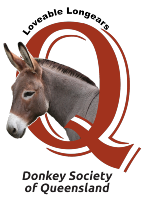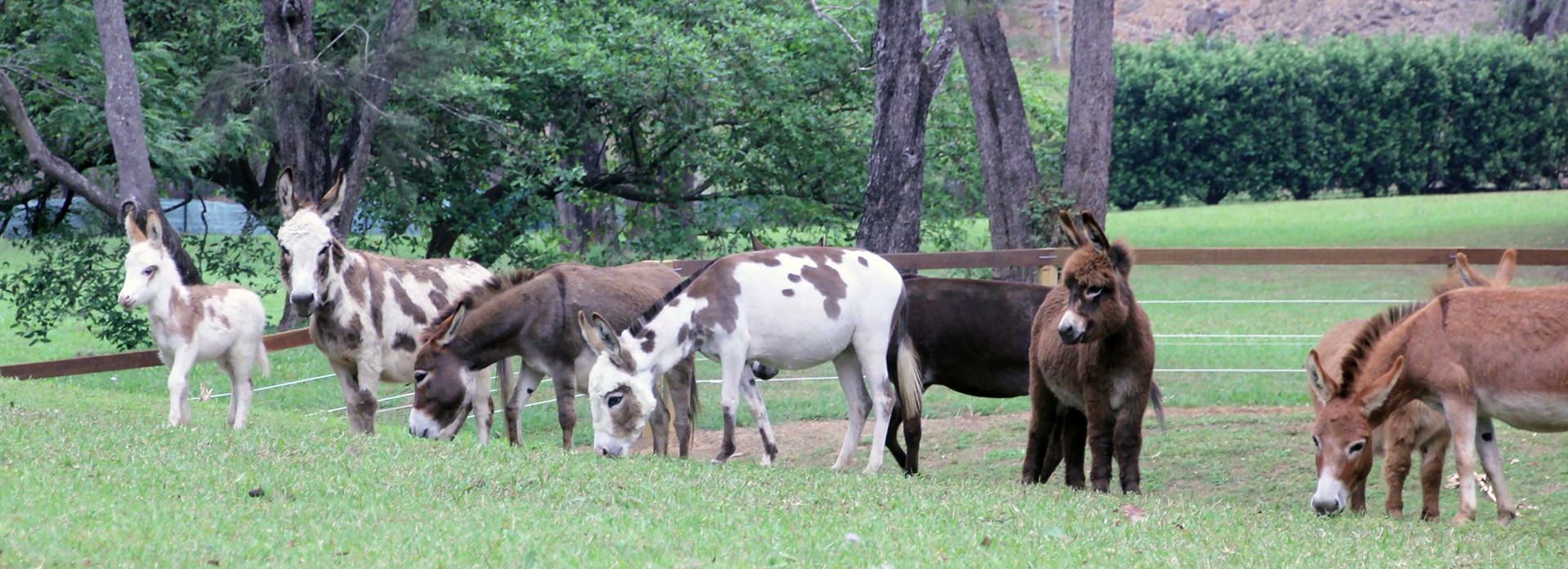


Where can I get a rescue donkey from?
The idea of ‘rescuing’ a donkey and giving it a loving home is a noble one. But be careful what you wish for. Typically, unwanted donkeys fall into three categories: companion donkeys that need rehoming due to an owner’s move or ill health, donkeys with severe ongoing health issues such as obesity or laminitis, or donkeys that no-one can approach. These could be wild-caught donkeys run through a saleyard, unhandled jacks or problem donkeys with a history of abuse/neglect. Before taking on one or so of these donkeys, ask yourself how experienced you are in livestock management and handling. Just relocating so-called ‘rescue’ donkeys to your place doesn’t immediately melt away their issues. This is just the start of the real work and too often we see people who have bitten off more than they can chew. The fact is that some of these animals are not suitable to be rehomed until they are retrained by someone with donkey experience. If you can do this, great but if you can’t, recognize your limitations and look around for something that is more suitable to your needs. Unfortunately, donkeys, like other animals, need more than just love alone to thrive.
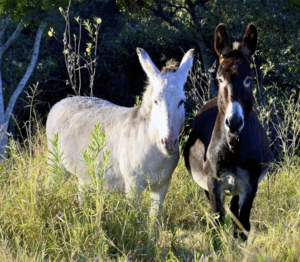
How long do donkeys live?
It’s not unheard of for donkeys to live to 50 years of age. That’s why they will pine terribly if their pal of, say, 30 years goes to donkey heaven. Just like humans, a donkey’s longevity depends on their background, current maintenance regime, existing health issues and accidents they may be involved in. And just like humans, some go on forever and others don’t. Christine Berry, in her book ‘Donkeys: Business As Usual’ tells us that a donkey between one and seven years is considered a young donkey; at eight years of age a donkey is fully grown; between eight and 12 years of age the donkey is referred to as mature; a teenage donkey is between 13 and 19 years; a middle-aged donkey is between 20 and 25 years; a senior donkey is between 25 and 30 years; and an old donkey is any age beyond that.

What do donkeys eat?
If it was up to the donkeys, they would tell you they were starving all the time and can eat virtually anything. But don’t be fooled. Just because they tell you they want certain foods doesn’t mean they are good for them. The donkey’s natural habitat is dry, arid regions where forage is sparse and of very low nutritional value. Donkeys will keep themselves alive eating every skerrick of dry grass, every seed, every root or strip of bark. They stay alive in conditions in which everything else starves. Donkeys have a number of unique adaptations that allow them to do this. The first adaptation is that feed passes through their digestive systems at a slower rate than it would through the tract of a horse or pony. This allows for greater digestion and absorption of nutrients, because feed is in contact with digestive enzymes and hindgut bacteria for a longer period of time. This is a good thing if the donkey is consuming feeds of very low nutritional value but can become a management challenge for modern-day owners in areas where feed quality is high and feed is readily available.
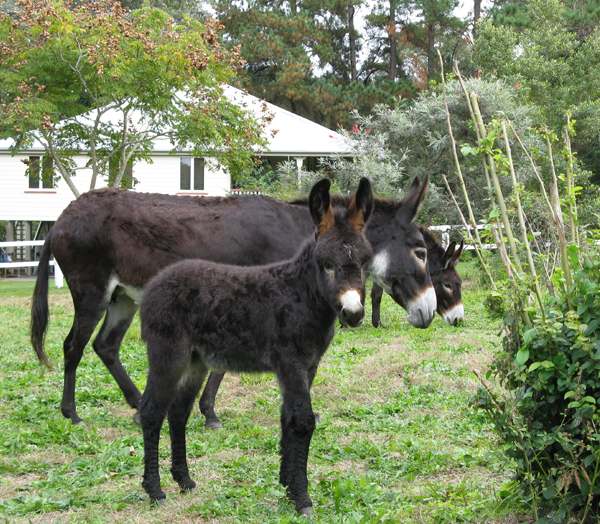
Will donkeys eat my trees and shrubs?
It’s likely. The importance of a donkey’s need for roughage cannot be underestimated. Donkeys have evolved to eat more than just grass. They happily eat browse (woody shrubs, trees and broadleaf plants) and forbs (flowering plants) as well. Donkeys have such a strong desire to browse that they can become quite destructive when forage is limited and sometimes even when it’s freely available. Providing sources of browse, such as brambles as well as tree branches and twigs, from safe tree species can give a donkey something to do and reduce destructive tendencies.
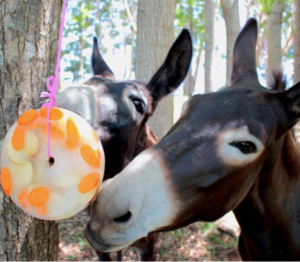
What about treats?
Given the opportunity, most donkeys will overeat to the point of obesity. There does not seem to be the ‘I’m full’ gene in the donkey’s make up. Treats should be fed sparingly and not necessarily according to what they tell you they want. For instance, we humans love things like chocolates, cakes, sweets and so on but that doesn’t mean it’s good for us to gorge on them all the time. Donkeys are similar so care should be taken with selecting healthy or healthier treats for them. Here is a general guide:
NO
• Bread or wheat-based breakfast cereals.
• Scones, desserts, cakes, biscuits, crumpets.
• Dry dog or cat food, chook food.
• Sugar cubes, fresh lawn clippings.
• General rule: If it’s refined it’s not natural.
YES
• Fruit slices e.g. apple, watermelon, banana, pear etc.
• Vegetable slices e.g. carrot, zucchini, pumpkin, orange sweet potato etc.
• Any seasonal fruit or vegetable that the donkey likes.
A word of caution: never give too much in one go as this can cause colic. Also, beware pips in stone fruit, cherries, mangoes etc. The golden rule is everything in moderation.
Licorice and peppermints are often used for training donkeys but this is another subject altogether.
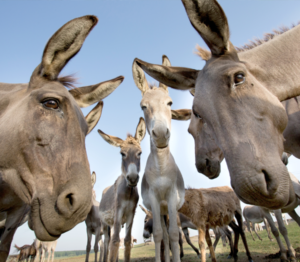
Management issues to be aware of
The four most important areas of ongoing health and welfare are: obesity, hoof care, de-worming and teeth. Incorrect feeding is the culprit behind obesity which comes with its own set of complex metabolic health problems such as colic. It also leads to laminitis or founder, a painful hoof condition where the donkey can no longer walk. Donkeys do not need shoeing like horses but they do require a donkey knowledgeable hoof trimmer to attend to the hooves regularly. This can be from 6-12 weeks’ duration, depending on the donkey, the hardness of the ground he is on and what condition his hooves are in.
De-worming on a regular basis is a must, particularly if the animal is on a small acreage where the paddocks should be rotated to disrupt the worm lifecycle and avoid cross-contamination. Otherwise, picking up the manure regularly will help and will also discourage flies in summer. Incorrect feeding combined with a lack of de-worming can also put your donkey on a path to suffering colic, a serious gut cramp that can be fatal.
Good teeth are crucial to an animal that relies on grazing for its very existence. A donkey’s teeth have to last a lifetime. There are no such fixes available like braces, implants or false teeth for donkeys so regular checks are the way to address any problems before they become major. A donkey’s teeth continuously grow and wear down. Sometimes this wearing of teeth is uneven, resulting in some teeth developing sharp edges which cause severe discomfort and loss of eating/digestion ability. It’s much the same as us having a bad toothache. A professional equine dentist or vet should check the donkey’s teeth at least every two years, preferably yearly depending on the age of the donkey and the condition of his teeth.

How much space do donkeys need?
Donkeys may be small (apart from Mammoths) but they need more room to exercise and graze than most people think. After all, this is an animal which has evolved to move constantly and travel between 40-60kms a day. Standing around and not doing much makes obesity and its associated problems that much harder to manage. According to the Good Samaritan Donkey Sanctuary NSW, a donkey needs a minimum of several acres to enable him to exercise – no less than five acres for the first donkey and no less than 8 acres to carry two donkeys. Any less than this will soon turn into a dust bowl or in wet weather will reduce to muddy ground potentially resulting in feet problems.
In our temperate Queensland climate, a stable is not necessarily needed but a shelter from sun, wind and rain is required. A three-sided shelter is ideal in an adequate size so all donkeys can shelter inside with plenty of room. The open side should face the mildest weather conditions. Often a north-facing structure is recommended for maximum protection from the summer sun and flies, the worst storms and wind. However, in our temperate climate, I find a south-facing structure gives the best results. Donkeys live happily with tin, brick or timber walls but may be tempted to nibble the timber so avoid treated pine. Feed the donkeys inside the shelter and hang their salt and mineral lick blocks there to avoid degradation out in the open weather. A nearby water source is desirable.
Owner’s checklist
• Your acreage – can it house two donkeys?
• Type of pasture – can it sustain two donkeys?
• Where to build a shelter and adjoining holding yard with water supply?
• Is the shelter far enough away from neighbours to prevent offence due to noise, dust and odour?
• Does the climate you live in suit donkeys? Too wet or too cold? Too much lush pasture?
• Do you have access to a donkey-knowledgeable vet and farrier?
• Do you have a nearby produce store for straw supply?
• How much time do you have to spend with your donkeys each week and attend to their needs?
• How willing are you to learn to train your donkeys in the basics (catching, halter, grooming, picking up feet calmly) if need be?
